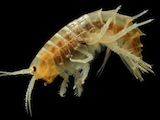Adrien Quiles PhD thesis
 Evolutionary history of microsporidia and amphipods symbioses: feminization and co-phylogeny
Evolutionary history of microsporidia and amphipods symbioses: feminization and co-phylogeny
Defended on the 13th December 2019
Funding: ANR CytoSexDet
Supervisors: Thierry Rigaud and Rémi Wattier
Started in October 2016
Abstract
Micropsoridia are a phylum of endosymbiotic eukaryotic microorganisms who realize their life cycle by infesting the cytoplasm of their hosts. This is a phylogenetically highly diverse phylum. Microsporidia were detected in many invertebrates and vertebrates species. Two transmissions strategies were observed, including either horizontal transmission (TH), from individual to individual within the host species or vertical transmission (TV), from the mother to its progeny. The first objective of this thesis is to explore the co-evolutionary history between microsporidia and is host for two species groups within the genus Gammarus (G. balcanicus and G. roeseli) for which the evolutionary history was recently resolved (Mamos et al 2016 ; Grabowski et al submitted). The second objective of this thesis is to focus on species Gammarus roeseli, for which the presence of three microspories, Nosema granulosis, Dictyocoela muelleri and D. roselum was demonstrated (Haine et al 2004). The TV, the feminization and the impact on the fitness of the host were clearly highlighted for N. granulosis (Haine et al 2007). The feminization character and the TV for the other two microsporidia are suspected and will be explored.
Keywords
symbiosis, microsporidia, amphipods, phylogeny, hosts, parasites
- extrait:
- lien_externe:
- kc_data:
- a:8:{i:0;s:0:"";s:4:"mode";s:0:"";s:3:"css";s:0:"";s:9:"max_width";s:0:"";s:7:"classes";s:0:"";s:9:"thumbnail";s:0:"";s:9:"collapsed";s:0:"";s:9:"optimized";s:0:"";}
- kc_raw_content:
 Evolutionary history of microsporidia and amphipods symbioses: feminization and co-phylogeny
Evolutionary history of microsporidia and amphipods symbioses: feminization and co-phylogenyDefended on the 13th December 2019
Funding: ANR CytoSexDet
Supervisors: Thierry Rigaud and Rémi Wattier
Started in October 2016
Abstract
Micropsoridia are a phylum of endosymbiotic eukaryotic microorganisms who realize their life cycle by infesting the cytoplasm of their hosts. This is a phylogenetically highly diverse phylum. Microsporidia were detected in many invertebrates and vertebrates species. Two transmissions strategies were observed, including either horizontal transmission (TH), from individual to individual within the host species or vertical transmission (TV), from the mother to its progeny. The first objective of this thesis is to explore the co-evolutionary history between microsporidia and is host for two species groups within the genus Gammarus (G. balcanicus and G. roeseli) for which the evolutionary history was recently resolved (Mamos et al 2016 ; Grabowski et al submitted). The second objective of this thesis is to focus on species Gammarus roeseli, for which the presence of three microspories, Nosema granulosis, Dictyocoela muelleri and D. roselum was demonstrated (Haine et al 2004). The TV, the feminization and the impact on the fitness of the host were clearly highlighted for N. granulosis (Haine et al 2007). The feminization character and the TV for the other two microsporidia are suspected and will be explored.
Keywords
symbiosis, microsporidia, amphipods, phylogeny, hosts, parasites
